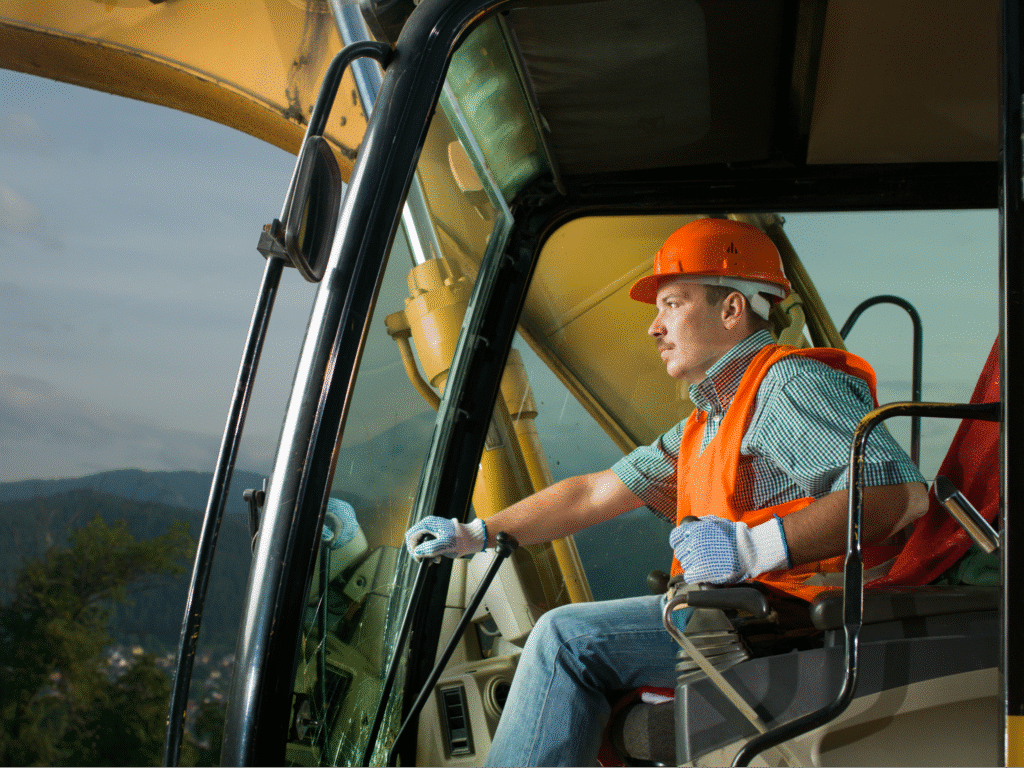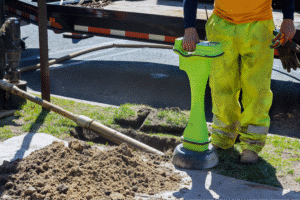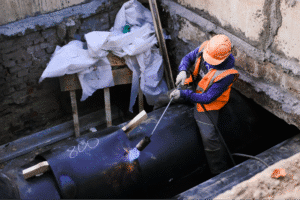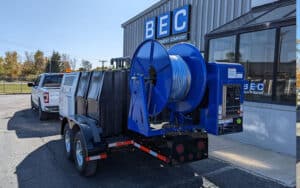Heavy machinery is the backbone of industries such as sewer management, roadway maintenance, snow and ice control, and landscaping. Operating equipment safely—from robust sewer cleaning trucks to agile snow-clearing vehicles—is essential for protecting workers, maintaining efficiency, and reducing downtime.
This guide provides actionable safety tips designed for professionals and decision-makers in heavy equipment operations. By adopting these practices, you can establish a safer work environment that builds trust, meets regulatory standards, and drives operational excellence.
The Importance of Safety Around Heavy Machinery
Heavy equipment inherently carries risks such as malfunctions, slips, falls, and collisions that may lead to serious injuries. In sectors like sewer and water management, using high-pressure systems in confined spaces introduces additional dangers, while roadway maintenance and snow management expose workers to unstable surfaces and moving traffic.
Implementing robust safety measures is a regulatory necessity as well as a strategic initiative. Effective protocols reduce repair costs, lower downtime, and protect your most valuable asset—your workforce. A strong safety culture also enhances employee morale and public trust.
Foundational Safety Practices
Establishing clear safety protocols is the first step toward a secure work environment. Focus on these essential practices:
- Personal Protective Equipment (PPE): Equip every worker with helmets, gloves, safety vests, goggles, and steel-toed boots. Additional gear such as hearing protection or slip-resistant footwear may be required based on the task.
- Designated Safety Zones: Mark areas around operating machinery with barriers, cones, or painted lines. This prevents accidental contact with moving equipment.
- Certified Operators Only: Authorize only trained and certified personnel to operate heavy machinery. Adequate training minimizes human error and ensures that emergency procedures and equipment limitations are clearly understood.
These steps form a robust foundation for all subsequent safety measures.
Safe Operation and Handling
Safe operation requires disciplined behavior and consistent oversight. Reducing risks involves thorough training and regular equipment checks.
Operator Training
Hands-on training is vital. Operators must understand how to control and maintain various machines—from sewer cleaning trucks and hydro excavation equipment to street sweepers. Regular refresher courses help both new and experienced operators stay current with evolving safety standards.
Pre-Operation Inspections
Before beginning any task, complete a comprehensive inspection:
- Verify fluid levels (oil, coolant, hydraulic fluids).
- Examine tires, brakes, lights, and alarm systems.
- Inspect hoses, connectors, and other critical components for signs of wear.
Routine checks enable early detection of faults and prevent issues from escalating into hazards.
Shutdown Procedures
After operations, follow strict shutdown protocols. Use lockout-tagout methods during maintenance to prevent accidental startups. These procedures safeguard both personnel and machinery.
Teamwork and Communication

Effective heavy machinery safety relies on clear communication and coordinated teamwork. A unified team minimizes risks and responds quickly during emergencies.
Clear Communication Channels
Provide teams with reliable communication tools, such as radios, and establish standard hand signals or visual cues. These measures ensure that every worker understands their role, even in noisy or low-visibility conditions.
Leadership and Oversight
Assign supervisors or safety officers to monitor daily activities, enforce protocols, and conduct pre-shift briefings. Their active oversight ensures hazards are promptly identified and managed.
Promoting Collaboration
Encourage team members to voice safety concerns. A collaborative atmosphere attracts valuable feedback and fosters a culture where safety is a joint responsibility.
The Role of Maintenance and Inspections

Regular maintenance is an investment in the longevity and safety of heavy machinery. Timely repairs and routine inspections prevent unexpected breakdowns.
Preventative Maintenance
Create and follow a preventative maintenance schedule. This should include regular servicing of brakes, hydraulic systems, and electrical components. Proactive maintenance reduces failures and extends equipment life.
Comprehensive Equipment Inspections
At the start of each work cycle, perform detailed inspections by:
- Looking for fluid leaks.
- Testing alarms, sensors, and safety locks.
- Confirming that bolts and mounts are secure.
These evaluations provide early warnings of potential issues and help maintain consistent performance. Whenever repairs are required, choosing Original Equipment Manufacturer (OEM) parts ensures full compatibility and maintains original safety specifications.
Adapting to Environmental Challenges
Environmental conditions can impact heavy machinery operations significantly. Adjust safety protocols based on weather and terrain.
Weather Considerations
- Snow and Ice: Winter conditions demand extra caution. Rely on Snow and Ice Management Equipment to tackle the toughest conditions safely. Equip vehicles with tire chains or specialized winter tires, and perform additional checks on brakes and fluid levels.
- Rain and Mud: Wet conditions can reduce stability. Carefully assess terrain for soft ground or hidden obstacles before commencing operations.
Terrain Adaptations
When working on uneven or sloped surfaces, take these precautions:
- Conduct a pre-job evaluation to assess ground conditions.
- Use remote-controlled equipment in high-risk areas when possible.
- Secure machinery with proper anchoring techniques.
These measures ensure the safety of both personnel and equipment regardless of environmental challenges.
Industry-Specific Safety Tips

Different industries have unique operational challenges that require tailored safety protocols.
Sewer Cleaning and Wastewater Management
- Daily Equipment Inspections: Routinely check hoses, nozzles, and connectors for wear or leaks in high-pressure systems.
- Specialized Training: Offer focused training on managing high-pressure water jets and handling confined space emergencies.
- Confined Space Protocols: Use fall protection harnesses and ensure proper ventilation in confined areas to safeguard workers.
Roadway and Highway Maintenance
- Securing Work Zones: Clearly mark work areas with cones, barriers, and temporary signage to keep moving traffic at a safe distance.
- Enhancing Visibility: Equip machinery with reflective decals and flashing lights, and ensure all workers wear high-visibility clothing.
- Coordinated Traffic Management: Maintain continuous communication with traffic coordinators to manage vehicle flow safely around work sites.
Snow and Ice Management
- Ensuring Stability: Regularly inspect snow-clearing vehicles to confirm they are properly configured for winter conditions, particularly paying attention to tire conditions and traction aids.
- Avoid Overloading: Refrain from overloading equipment, such as grapple trucks, to maintain stability.
- Regular Cleaning: Remove accumulated snow and ice from machinery to preserve performance and unobstructed sightlines.
Landscaping and Vegetation Maintenance
- Hazard Awareness: Assess the terrain for hidden objects or uneven ground before operating mowers or attachments.
- Safe Debris Handling: Ensure workers wear appropriate protective gear to guard against flying debris.
- Proper Equipment Selection: Choose specialized landscaping and vegetation equipment solutions to handle slope mowing, land clearing, and more with greater safety.
Avoiding Common Safety Mistakes
Avoiding common pitfalls is essential for a secure environment. Keep these key points in mind:
- Skipping Routine Maintenance: Failure to perform scheduled maintenance can lead to sudden, dangerous equipment failures.
- Underestimating Environmental Hazards: Always adjust safety measures based on current weather or terrain conditions.
- Poor Communication: Ensure all communication channels are operational to prevent critical errors.
- Improper Storage: Secure tools and materials properly to prevent them from becoming hazardous during operations.
Advanced Practices for Enhancing Machinery Safety

Enhancing safety further involves integrating advanced practices and technologies.
Smart Technology Integration
Modern machinery increasingly features smart sensors and telematics systems—digital tools that monitor performance in real time. These systems detect issues like overheating or unusual vibrations, allowing for preemptive maintenance and reducing unexpected failures.
Virtual Training Simulations
Virtual reality (VR) training provides immersive experiences, allowing operators to safely practice emergency scenarios. This method improves response times and builds confidence without real-world risk.
Continuous Safety Education
Ongoing education through workshops and on-site training sessions, ensures that employees stay up-to-date on the latest safety protocols and technologies. Tailored training helps every team member recognize potential hazards and respond appropriately.
Emerging Innovations in Heavy Machinery Safety
Technological advances are reshaping the way safety is managed:
- Diagnostic Software: Advanced software can monitor equipment performance and environmental conditions in real time, sending alerts when issues arise.
- Augmented Reality (AR): AR tools offer overlay instructions and visual checklists during maintenance tasks, guiding operators through complex procedures.
By incorporating these innovations, organizations can significantly reduce risks and ensure consistent safety practices.
Fostering Continuous Improvement in Safety Culture
A commitment to continuous improvement is vital for maintaining long-term safety. Organizations that prioritize learning and proactive safety strategies consistently reduce workplace hazards. Regular analysis of near-miss incidents, combined with feedback from team members, helps refine safety protocols.
Establishing dedicated safety committees to review incidents and conduct periodic audits further evolves operational practices. Encouraging employee suggestions fosters a culture where safety is paramount and continuously improved.
Leveraging Data Analytics for Predictive Safety
In an era of digital transformation, data analytics plays a critical role in enhancing heavy machinery safety. By collecting data from on-board sensors related to engine performance, hydraulic pressure, and machine vibrations, organizations gain real-time insights into equipment health. Predictive analytics can identify subtle trends and anomalies that may indicate potential failures well before they occur.
When patterns show early signs of inefficiencies, teams can schedule timely repairs or recalibrations, preventing hazards before they escalate. Moreover, analyzing historical data improves the overall understanding of equipment behavior under different operating conditions, enabling maintenance teams to prioritize interventions based on risk factors. This data-driven approach enhances operational efficiency and safeguards workers.
Regulatory Compliance and Industry Standards
Adherence to regulatory compliance and industry standards is a cornerstone of safe heavy machinery operations. Organizations must continually update their safety protocols to meet or exceed federal, state, and local regulations. Regular audits and safety reviews ensure that all practices align with established guidelines. Compliance not only minimizes legal risks but also builds trust with workers and the community.
In many industries, adopting best practices and obtaining certification from recognized bodies can further enhance safety standards while providing a framework for continuous improvement. Detailed documentation, periodic training updates, and a thorough review of incident reports are essential steps in meeting regulatory requirements.
Stay Safe and Efficient at the Jobsite

Creating a safe operational environment requires comprehensive training, diligent maintenance, clear communication, and a commitment to continuous improvement. By implementing these crucial heavy machinery safety tips, you can safeguard your workforce, prevent accidents, and enhance overall performance.
At Brown Equipment Company, we are dedicated to offering expert equipment support, free live demonstrations, and operations training upon delivery of the equipment. Contact us today to empower your team with industry-leading safety solutions and ensure your operations continue to run safely and efficiently.



